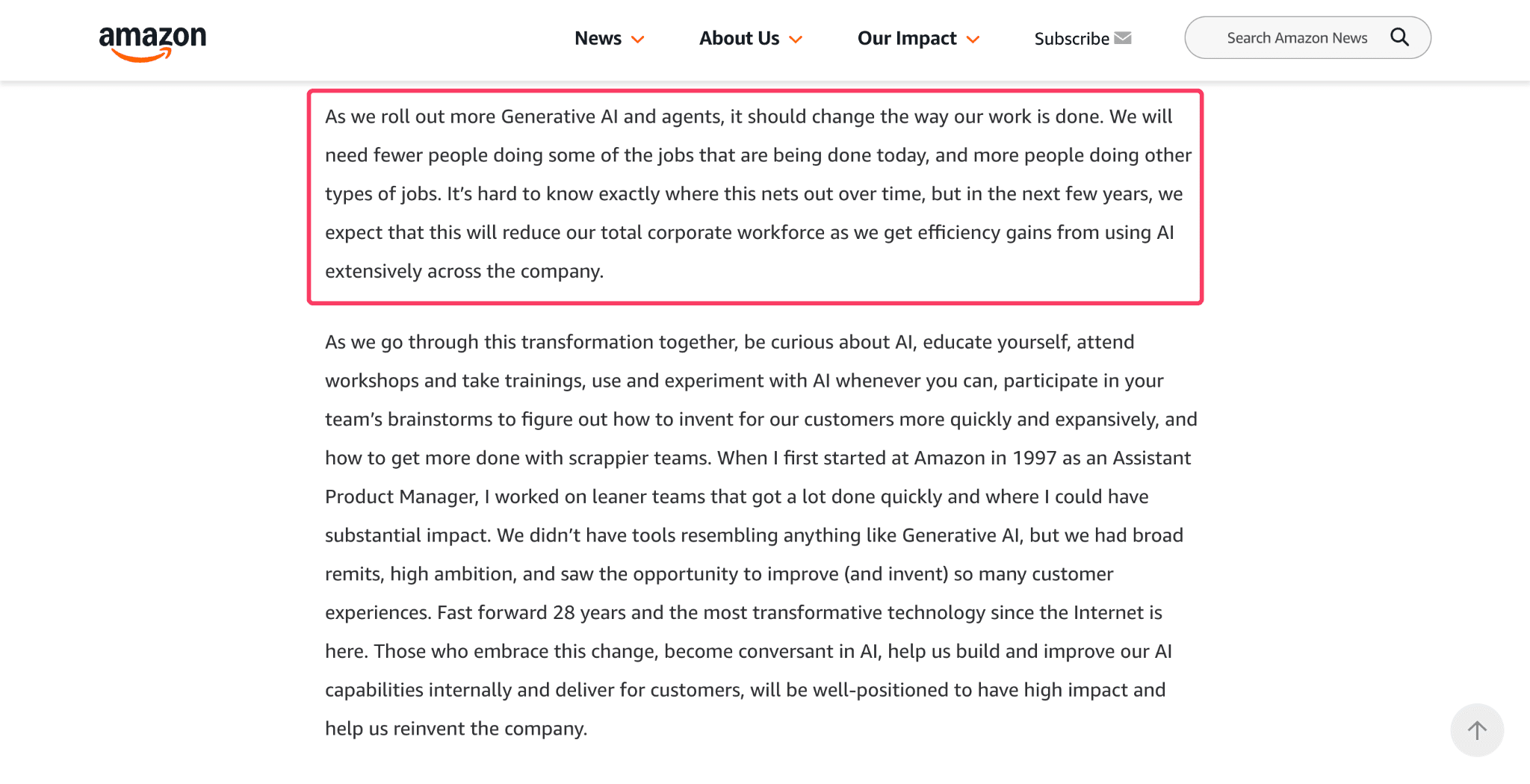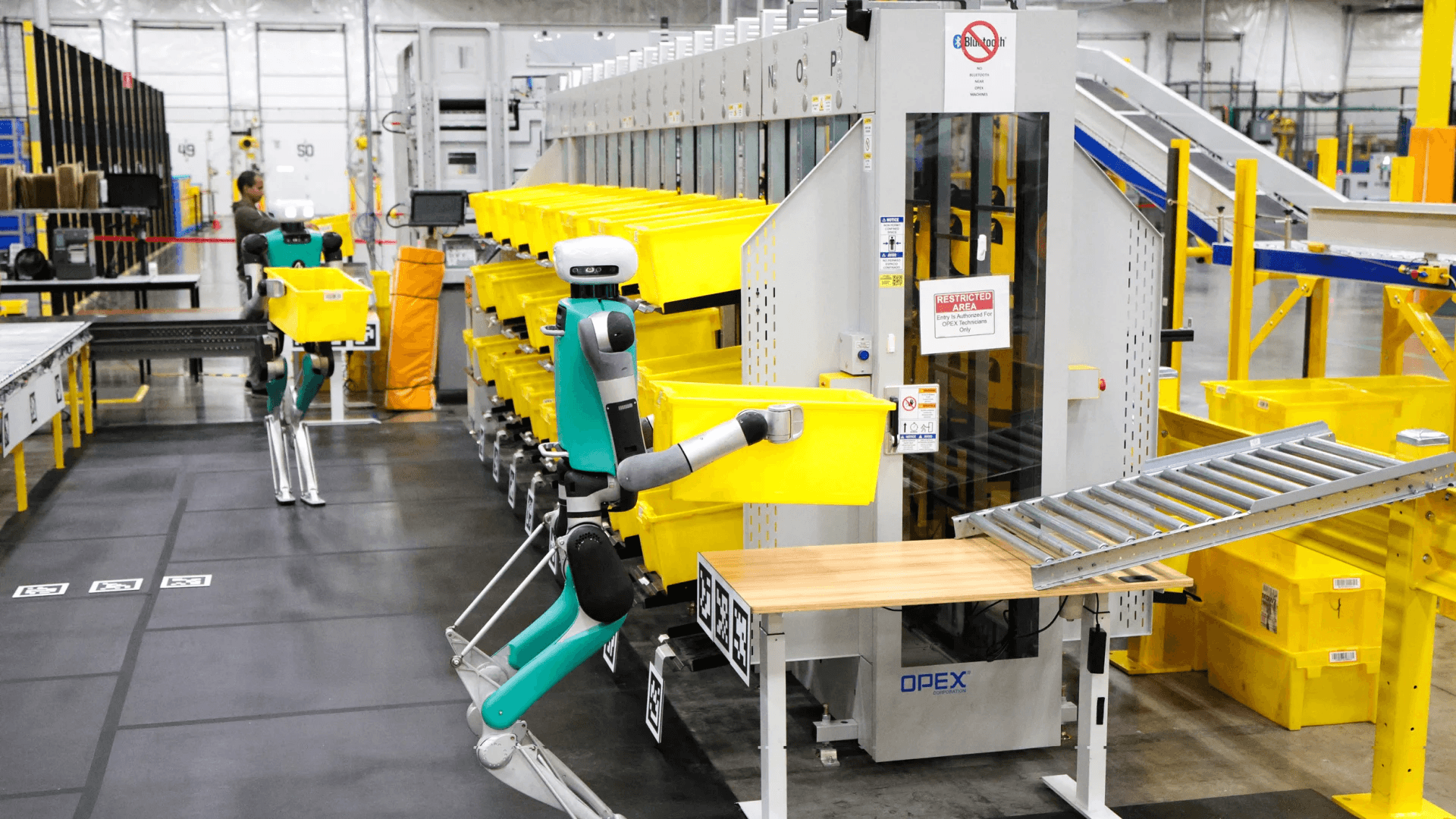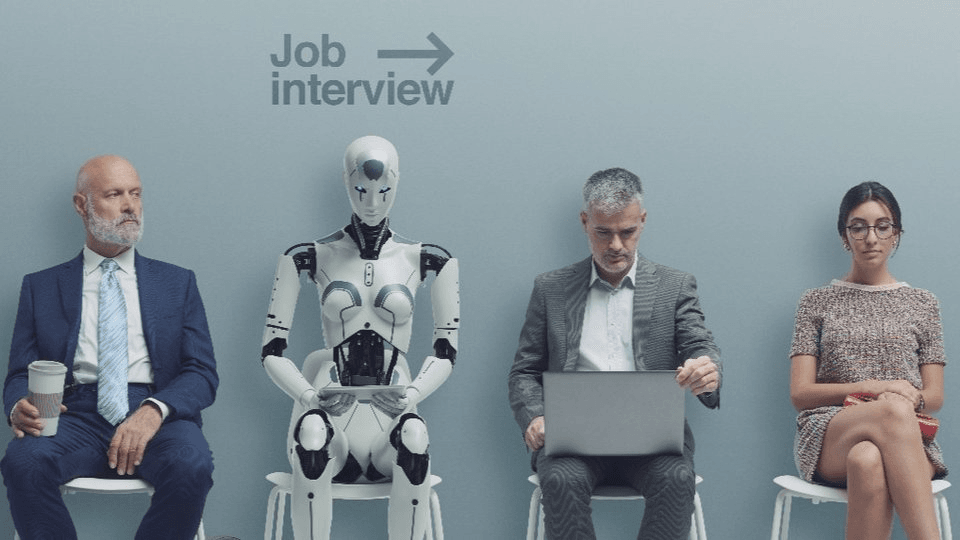The moment many workers have been dreading just happened. Amazon's CEO Andy Jassy openly told employees that AI will help the company reduce its workforce in the coming years. This is not a rumor or speculation anymore - it is an official statement from one of the world's largest employers.
Amazon employs over 1.5 million people worldwide. When a company this size announces AI will replace human workers, it sends shockwaves through every industry. Other major companies are quietly making similar moves, but Amazon chose to be direct about it.
This announcement affects more than just Amazon employees. It shows us what the future of work looks like across all industries. From entry-level office jobs to specialized roles, AI is changing how businesses operate and who they need to hire.
We will explore what Amazon actually said, why they are making this move now, which jobs are most at risk, and what workers can do to stay relevant in an AI-driven world.
Let's get into it.
Amazon Just Made Everyone's AI Job Fears Real

Amazon CEO Andy Jassy just said something that workers everywhere have been dreading to hear. In an internal memo ( also available on amazon official blog) to employees, he clearly stated that AI will help the company reduce its workforce in the coming years. This is not just a guess or theory anymore - it's an official statement from one of the world's biggest companies.
For months, workers have been nervous about losing their jobs to AI. Many people wondered if these fears were real or just panic. Jassy's announcement shows these worries are valid.

What makes this announcement different:
- This comes directly from Amazon's CEO, not from rumors or news reports
- Amazon employs over 1.5 million people worldwide
- The company is being honest about AI replacing human workers
- Other tech companies have made similar moves but were less direct about it
Why this matters more than typical layoffs:
- Traditional layoffs happen due to money problems or business changes
- These job cuts are specifically because AI can do the work better
- This signals a permanent shift in how companies will operate
- It sets a pattern that other major companies may follow
This announcement turns workplace fears into workplace reality.
Why Amazon Is Making This Move Now

Amazon is moving forward with AI job changes because the technology has reached a point where it can handle many human tasks effectively. AI systems can now work faster, make fewer mistakes, and operate around the clock without breaks or benefits.
The business case is simple - AI costs less than human workers over time. While there are upfront costs to build and deploy AI systems, they become cheaper to run than paying salaries, health insurance, and other employee expenses.
How AI has improved recently:
- AI can now understand and respond to complex requests
- Machine learning systems get better at tasks with more practice
- AI can handle multiple jobs at the same time without getting tired
- The technology has become more reliable and accurate
Amazon's current AI uses:
- Customer service chatbots that answer questions instantly
- Inventory systems that predict what products to stock
- Warehouse robots that move and sort packages
- AI that writes and improves product descriptions
- Systems that optimize delivery routes and timing
Amazon sees AI as the future of business efficiency.
Which Jobs Are Most at Risk?

Not all jobs face the same level of risk from AI replacement. Some positions are much easier for AI to take over, while others remain safe because they require human skills that AI cannot match yet.
Entry-level jobs are often the first to go because they usually involve simple, repeated tasks. AI systems can learn these tasks quickly and perform them without supervision. White-collar office work is also at risk, especially jobs that involve processing information or following set procedures.
Jobs at highest risk:
- Data entry and basic analysis positions
- Customer service representatives who handle simple requests
- Junior accountants who process routine financial tasks
- Retail workers who scan items or manage inventory
Jobs that are safer:
- Positions requiring creative problem-solving and human judgment
- Jobs that need face-to-face interaction and emotional understanding
- Roles that involve complex decision-making with many variables
- Work that requires physical skills AI cannot replicate yet
Why some jobs are protected:
- They need human creativity and original thinking
- They require understanding of emotions and social situations
- They involve unpredictable tasks that change frequently
The key difference is whether a job follows patterns that AI can learn.
Is This Just an Amazon Problem?

Amazon is not alone in this shift toward AI replacing human workers. Many other major companies are making similar moves, showing that this is a widespread trend across different industries.
Other tech giants like Microsoft, Google, and Salesforce have already reduced their workforce or slowed hiring because AI tools help their remaining employees do more work. Some companies are being direct about it, while others are making these changes quietly.
Other companies making similar moves:
- Microsoft has laid off thousands while emphasizing AI productivity gains
- Google has reduced hundreds of positions in recent months
- Salesforce CEO suggested they might not hire engineers because AI makes current staff more productive
- Shopify now requires proof that AI cannot do a job before hiring anyone new
Industries beyond tech affected:
- Banking and finance are automating customer service and data analysis
- Healthcare is using AI for scheduling and basic patient interactions
- Retail companies are replacing cashiers with self-checkout systems
- Manufacturing has been using robots for years and is expanding AI use
This trend is spreading because AI technology works across many different types of businesses, not just tech companies.
The Numbers Behind AI Job Changes

The scale of AI-related job changes is becoming clearer through recent data and expert predictions. Tech companies have already laid off significant numbers of workers, with many citing AI efficiency as a reason.
In 2025 alone, 141 tech companies have eliminated over 62,000 jobs. The previous year saw even larger numbers, with more than 150,000 workers losing their positions across the tech industry.
Current layoff patterns:
- Tech layoffs are happening faster than in previous years
- Many companies are specifically mentioning AI as a factor
- Entry-level positions are disappearing at higher rates
- Some companies are freezing new hiring entirely
Expert predictions:
- Some experts warn that AI could eliminate half of all entry-level white-collar jobs
- Others predict unemployment could reach 20% in the next few years
- However, the World Economic Forum suggests AI will create 78 million new jobs overall
- The math shows that for every job lost, three or four new ones might be created
The challenge is that new jobs often require different skills than the ones being eliminated.
What Workers Can Do to Stay Relevant

Workers do not need to fear AI if they focus on developing skills that technology cannot easily replace. The key is learning how to work with AI as a partner rather than seeing it as competition.
Human skills like creativity, emotional understanding, and complex problem-solving remain valuable because AI struggles with these areas. Workers who can combine their human abilities with AI tools often become more productive and valuable to employers.
Skills that protect against AI replacement:
- Creative thinking and original idea generation
- Leadership and team management abilities
- Complex communication and negotiation skills
- Critical thinking for unusual problems
- Emotional intelligence and empathy
Working with AI effectively:
- Learn to use AI tools to enhance your current work
- Focus on tasks that require human judgment and oversight
- Develop skills in managing and directing AI systems
- Become skilled at checking and improving AI output
Career preparation options:
- Take online courses in AI collaboration and management
- Learn technical skills that complement AI rather than compete with it
- Develop expertise in areas where human insight remains essential
Conclusion
Amazon's announcement about AI replacing workers marks a turning point in how we work and live. This is not just about one company making business decisions - it signals the beginning of a major shift in society.
The CEO's honest statement confirms what many workers feared: AI will eliminate jobs across industries. However, this change also creates opportunities for those who adapt quickly. Amazon's move will likely encourage other companies to follow similar paths, making AI adoption faster across all business sectors.
What future society might look like:
- More jobs will require working with AI rather than doing tasks AI can handle
- Education systems will need to teach AI collaboration from an early age
- New types of jobs will emerge that we cannot imagine today
- The gap between AI-ready workers and others may create social challenges
The key to thriving in this future is preparation. Workers who learn to use AI as a tool rather than fear it as a threat will find more success. Amazon's decision forces everyone to think seriously about their career path and skills.
FAQs
1. Will Amazon fire employees because of AI?
Amazon CEO Andy Jassy confirmed that AI will reduce the company's corporate workforce over the next few years. These are not immediate layoffs but gradual workforce changes as AI takes over routine tasks and improves efficiency across company operations.
2. What jobs will AI replace first at Amazon?
AI will primarily replace entry-level positions involving routine tasks like data entry, basic customer service, inventory management, and simple analysis work. Jobs requiring creativity, complex problem-solving, and human interaction are safer from AI replacement.
3. How many jobs will AI eliminate in the future?
Experts predict AI could eliminate half of entry-level white-collar jobs within five years. However, the World Economic Forum estimates AI will create 78 million new jobs overall, meaning three to four new positions for every job eliminated.
4. Which companies besides Amazon are cutting jobs for AI?
Microsoft, Google, Salesforce, and Shopify have all reduced hiring or eliminated positions due to AI efficiency gains. Tech companies laid off over 62,000 workers in 2025 alone, with many citing AI as a contributing factor to workforce reductions.
5. How can workers protect their jobs from AI replacement?
Workers should develop skills AI cannot replicate like creativity, leadership, emotional intelligence, and complex problem-solving. Learning to work alongside AI tools rather than competing with them makes employees more valuable and productive to employers.

![Best AI Tools for COOs Managing Confidential Data & Operations [2026 Study]](https://assets.superblog.ai/site_cuid_cl495vqej08071jpawt8inf39/images/a-flat-vector-style-illustration-featurityjvm9kas5m25jbi7ok94a4-05p3k-tlu196gydhjlxg-1765379846137-compressed.png)
![12 Best AI Tools for CHROs: Automate Recruiting, Engagement & Analytics [2026 GUIDE]](https://assets.superblog.ai/site_cuid_cl495vqej08071jpawt8inf39/images/a-flat-colorful-illustration-of-a-profes3lg5dahs6e50g19rranfgbgiidh3jswuudan2altv9q-1765378364310-compressed.png)
![Best AI Project Management Software: 12 Tools Compared [2026 Guide]](https://assets.superblog.ai/site_cuid_cl495vqej08071jpawt8inf39/images/a-flat-colorful-illustration-featuring-a0ert4ownqhingorc2ibulgh-nv7vuys0gndyrmzirruq-1764778736290-compressed.png)